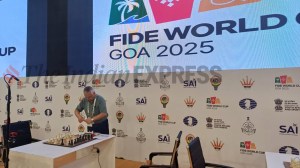Numismatologist says they belonged to Kalachuri times in the post-Vakataka period
NAGPUR, SEPT 14: While a majority of the ancient Nandapuri silver coins remain untraceable, they have been finally positively identified, ...

NAGPUR, SEPT 14: While a majority of the ancient Nandapuri silver coins remain untraceable, they have been finally positively identified, bringing the series of hypotheses about the issuers of the coins to an end.
The coins have been identified as those issued by Kalachuri King Krishnaraj of Mahishmati region in Madhya Pradesh, who ruled from 550 to 575 AD. It is well-known in history that in the post-Vakataka period (fifth/sixth century), the Vidarbha region was ruled by the Kalachuris of Mahishmati through Swamirajas (deputed rulers).
The identification has been made by Dr Ajay Mitra Shastri, eminent numismatologist from the city. Dr Shastri’s views have been seconded by Dr A K Sharma, archaeologist, who was instrumental in the recovery and initial decoding of the coins. It was earlier suggested by Dr Sharma that the coins might have been issued by one of the lesser-known successors of Pravarsena-I, a prominent Vakataka king.
The silver coins, found allegedly in two earthen pots from a pit in village Nandapuri near Ramtek here last month, have been in the centre of controversy as majority of them have remained untraced till now.
Giving details about the Kalachuri coins, Dr Shastri mentioned that these coins have been known since more than a century now and are found over an extensive area covering large parts of Madhya Pradesh and Maharashtra. A large cache of similar coins was found in Dhamori area of Amravati district in 1923. Some of these coins have now been kept in Central Museum, Nagpur, for the benefit of common people.
The typicality of these coins is that they have the king’s head with a prominent moustache facing right on the obverse side. On the reverse side, it has a dotted circle along the edge with the Brahmi (Sanskrit language) legend `Param-Maheshwara-mata-pitri-padanudhyata-Shri-Krishnarajah’. The legend describes Krishnaraj, the issuer of these coins, as a devout worshipper of God Maheshwara (Shiva) and a king who was devoted to his parents. In the centre, there is a figure of Nandi (mount of Lord Shiva) — on two parallel lines with three dots in between.
These coins, Dr Shastri said, bear a close resemblance to the silver coins of the Western Kstrapa rulers – who ruled before and contemporaneously with the Vakatakas – in the Malwa region of MP, Gujarat and Konkan region of Maharashtra for a brief spell. He said that the Western Kstrapa coins became very popular and widely acceptable over a large area during that period mainly because of the long period of their issuance and circulation and the comparative purity of the metal.
Another reason was the non-issuance of silver coins by most of the other contemporary dynasties. In the absence of their own coins, the ruling families might have allowed the use of Kstrapa coins as legal tenders in their areas.
Dr Shastri further mentioned that as the Kstrapa coins were already in circulation in Vidarbha during the advent of the Kalachuris, Krishnaraja, who is the first known Kalachuri king, might have issued similar-looking coins with a different legend and his own bust.
He said that anyway, the finding of these coins in the Mansar area is of great value for political and economic history of the region, as it more than ratifies the fact that the Kalachuris ruled Vidarbha in the post-Vakataka period.
The fact has come to light through an earlier inscription, found at Nagardhan (very near Nandapuri). The finding of these coins also demonstrates that Kalachuri coins served as legal tender during the post-Vakataka period.





- 01
- 02
- 03
- 04
- 05

























